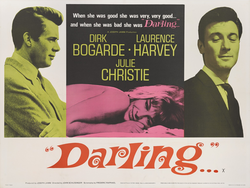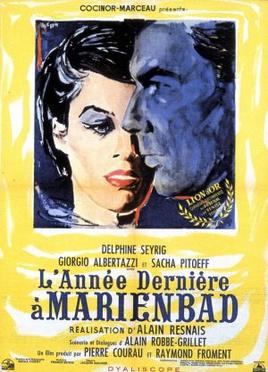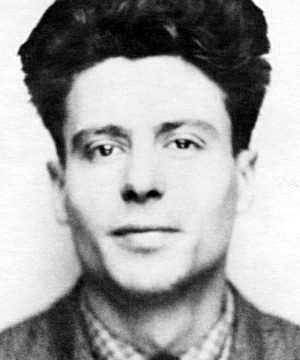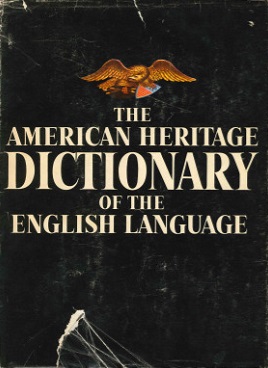
Brian Russell De Palma is an American film director and screenwriter. With a career spanning over 50 years, he is best known for his work in the suspense, crime and psychological thriller genres. De Palma was a leading member of the New Hollywood generation of film directors. His direction often makes use of quotations from other films or cinematic styles, and bears the influence of filmmakers such as Alfred Hitchcock and Jean-Luc Godard.

The Best Years of Our Lives is a 1946 American epic drama film directed by William Wyler and starring Myrna Loy, Fredric March, Dana Andrews, Teresa Wright, Virginia Mayo and Harold Russell. The film is about three United States servicemen re-adjusting to societal changes and civilian life after coming home from World War II. The three men come from different services with different ranks that do not correspond with their civilian social class backgrounds.
Alain Resnais was a French film director and screenwriter whose career extended over more than six decades. After training as a film editor in the mid-1940s, he went on to direct a number of short films which included Night and Fog (1956), an influential documentary about the Nazi concentration camps.

Darling is a 1965 British romantic drama film directed by John Schlesinger from a screenplay written by Frederic Raphael. It stars Julie Christie as Diana Scott, a young successful model and actress in Swinging London, toying with the affections of two older men, played by Dirk Bogarde and Laurence Harvey. The film was shot on-location in London, Paris and Rome and at Shepperton Studios by cinematographer Kenneth Higgins, with a musical score composed by Sir John Dankworth.

Last Year at Marienbad is a 1961 Left Bank film directed by Alain Resnais from a screenplay by Alain Robbe-Grillet. Set in a palace in a park that has been converted into a luxury hotel, it stars Delphine Seyrig and Giorgio Albertazzi as a woman and a man who may have met the year before and may have contemplated or started an affair, with Sacha Pitoëff as a second man who may be the woman's husband. The characters are unnamed.

Jean Vigo was a French film director who helped establish poetic realism in film in the 1930s. His work influenced French New Wave cinema of the late 1950s and early 1960s.

The American Heritage Dictionary of the English Language (AHD) is an American dictionary of English published by Boston publisher Houghton Mifflin, the first edition of which appeared in 1969. Its creation was spurred by the controversy over the perceived permissiveness of the Webster's Third New International Dictionary. The third edition included over 350,000 entries and meanings.
Kyril Bonfiglioli was an English art-dealer, magazine editor and comic novelist. His eccentric and witty Mortdecai novels have gained a following since his death.

Michael Antonio Cimino was an American filmmaker. One of the "New Hollywood" directors, Cimino achieved fame with The Deer Hunter (1978), which won five Academy Awards, including Best Picture and Best Director.

Carl Theodor Dreyer, commonly known as Carl Th. Dreyer, was a Danish film director and screenwriter. Widely considered one of the greatest filmmakers of all time, his movies are noted for emotional austerity and slow, stately pacing, frequent themes of social intolerance, the inseparability of fate and death, and the power of evil in earthly life.

Nik Cohn, also written Nick Cohn, is a British writer.

Point Blank is a 1967 American crime film directed by John Boorman, starring Lee Marvin, co-starring Angie Dickinson, Keenan Wynn and Carroll O'Connor, and adapted from the 1963 crime noir pulp novel The Hunter by Donald E. Westlake, writing as Richard Stark. Boorman directed the film at Marvin's request and Marvin played a central role in the film's development. The film was not a box-office success in 1967, but has since gone on to become a cult classic, eliciting praise from such critics as film historian David Thomson.

David Thomson is a British film critic and historian based in the United States, and the author of more than 20 books.

Kevin Brownlow is a British film historian, television documentary-maker, filmmaker, author, and film editor. He is best known for his work documenting the history of the silent era, having become interested in silent film at the age of eleven. This interest grew into a career spent documenting and restoring film. Brownlow has rescued many silent films and their history. His initiative in interviewing many largely forgotten, elderly film pioneers in the 1960s and 1970s preserved a legacy of early mass-entertainment cinema. He received an Academy Honorary Award at the 2nd Annual Governors Awards given by the Academy of Motion Picture Arts and Sciences on 13 November 2010. This was the first occasion on which an Academy Honorary Award was given to a film preservationist.

The Monthly Film Bulletin was a periodical of the British Film Institute published monthly from February 1934 to April 1991, when it merged with Sight & Sound. It reviewed all films on release in the United Kingdom, including those with a narrow arthouse release.

Michael is a 1924 German silent drama film directed by Carl Theodor Dreyer, director of other notable silents such as The Passion of Joan of Arc (1928), Master of the House (1925), and Leaves from Satan's Book (1921). The film stars Walter Slezak as the titular Michael, the young assistant and model to the artist Claude Zoret. Along with Different From the Others (1919) and Sex in Chains (1928), Michael is widely considered a landmark in gay silent cinema.
Brian Lester Glanville is an English football writer and novelist. He was described by The Times as "the doyen of football writers—arguably the finest football writer of his—or any other—generation", and by American journalist Paul Zimmerman as "the greatest football writer of all time."
Ephraim Katz was a writer, journalist and filmmaker who devoted his life to gathering the information in his book, The Film Encyclopedia, first published in 1979.
Voyage to Cythera is a 1984 Greek film directed by Theodoros Angelopoulos. It was entered into the 1984 Cannes Film Festival, where it won the FIPRESCI Prize and the award for Best Screenplay.

The bibliography of George Orwell includes journalism, essays, novels, and non-fiction books written by the British writer Eric Blair (1903–1950), either under his own name or, more usually, under his pen name George Orwell. Orwell was a prolific writer on topics related to contemporary English society and literary criticism, who has been declared "perhaps the 20th century's best chronicler of English culture." His non-fiction cultural and political criticism constitutes the majority of his work, but Orwell also wrote in several genres of fictional literature.















